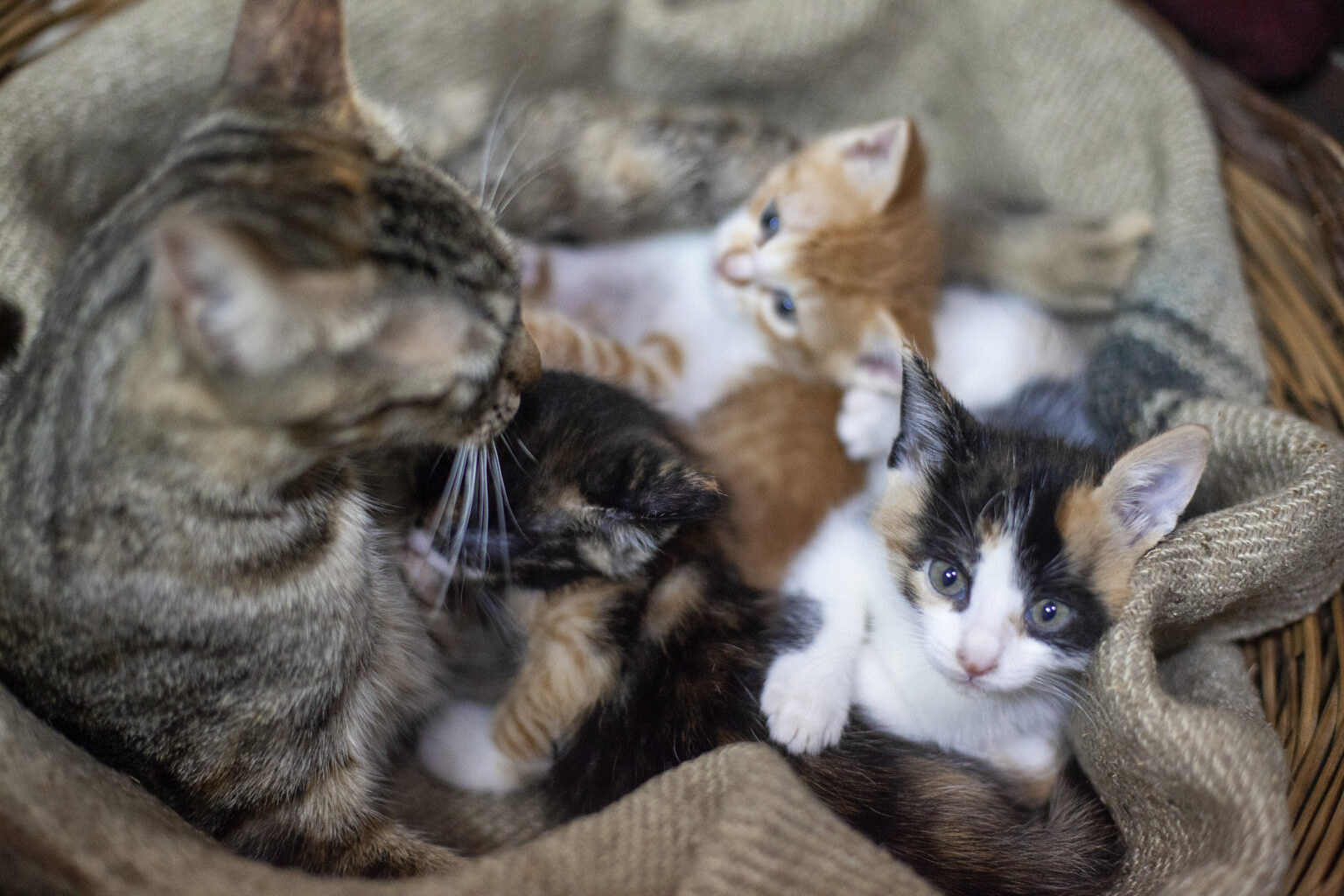Cats can become pregnant very easily. Pregnancy can occur whenever a female (known as a “queen”) is in heat, which takes place several times a year from spring to autumn. The average feline pregnancy lasts between 60 and 65 days. As female cats are able to become pregnant from 4 months old (while she is still very much a kitten herself), it is recommended to have your cat spayed as close as possible to this age to avoid adding to the unwanted cat population. However, if you are planning to breed your cat, this is what to expect when she is expecting.
Signs of pregnancy
- After 2 weeks, the nipples become enlarged and red, known as ‘pinking-up’.
- A pregnant cat may also go through a stage of being sick occasionally.
- Your cat will gradually gain between one and two kilograms, depending on the number of kittens. This is a strong indication that she is pregnant.
- The abdomen will start to swell, but avoid touching it too firmly to avoid the risk of damaging the unborn kittens.
- Before giving birth, your cat’s behaviour will become “maternal” and she may begin to purr a lot.
- She is likely to refuse food, will act unsettled and might start to look for a suitable quiet place in which to give birth.
- The first sign of labour is a temperature drop in the mother to around 37.8º C.
- You should then see the abdomen contracting and vaginal discharge (if the discharge is heavy and black or blood coloured then you should contact your vet).
Do
- Make sure your cat sees a vet early in the pregnancy.
- Examine her for fleas, ticks and lice as these could affect the health of her kittens.
- Feed your cat kitten food until she finishes nursing.
- Increase your cat’s feedings during pregnancy — she will probably need to eat around 1.5 times more than usual.
- Place a comfortable birthing box in a warm room about 2 weeks before your cat is due to give birth.
Don’t
- Don’t touch your cat’s pregnant belly – this could cause abortion or damage.
- Don’t carry out worming after 2 weeks of pregnancy.
- Don’t interrupt the birthing process unless there are any complications.
Stages of pregnancy
Stage 1 – Pre-implantation (from Days 0 – 12) Egg fertilisation: This is when the egg is fertilised in the uterine tube. It then travels down the oviduct and enters the uterus, on about the sixth day of development. In the uterus it is covered by special cells that are implanted in the uterus wall. Certain cells cluster together at one end forming the embryo (the new kitten) whilst the other parts will make up the placenta. The placenta is the connection between the mother and kitten.
Stage 2 – Embryogenesis (Day 12 – 24) critical period: This is when the nervous system, heart and vertebral column (spine) are established. Then blood vessels appear within the embryo (kitten) and between the embryo and the placenta. All this happens in just two to three days. Then the liver, digestive tract, respiratory system, limbs, sense organs, skull and bladder etc. begin to be formed. The kitten measures just 1/8th of an inch at 15 days, 3/8ths of an inch at 21 days and 5/8ths of an inch at 24 days. A vet (this should not be done by someone inexperienced, as damage could be caused) can feel the kittens by abdominal palpation at twenty days after conception. At about three weeks, the cat’s nipples begin to pink up and slightly enlarge. The fur on the queen’s belly and around the nipples may become thinner.
Stage 3 – Foetal growth (Day 24 to Birth) rapid growth time: The organs take on their proper shape, nerves develop, and the hormonal glands begin to function and control the processes. This continues to develop even after birth, for example; full development of the eyes is not accomplished until five to six weeks after birth, and nerve cells in the brain continue to form and develop for several months. At four weeks from conception, the kittens are just over an inch in size. By day 35 the kittens are floating in capsules of fluid and can’t be felt until day 49, when their heads are large enough to be felt as separate structures. This should only be done by a vet because damage or miscarriage could easily be caused. The later signs of pregnancy are a pear-shaped abdomen, foetal movements should also be observable during the last two weeks. Breasts will also enlarge and a milky fluid may be expressed from the nipples. There may be clear or blood-tinged discharge from the vulva 12 to 24 hours before the cat is due to deliver.
Diagnosis
Veterinary examinations should be carried out as soon as you suspect your cat is pregnant. Pregnancy diagnosis can be achieved by the following methods:
- Enlargement and pink colour of the teats and mammary glands (from day 18)
- Ultrasound (from day 18)
- Abdominal palpation of the uterus, individual foetuses, and foetal membranes (from 20 to 30 days)
- Ultrasonic detection of placenta and foetal heartbeat (from 30 days)
- X-ray of the abdomen (from 40 days)
Behaviour
Your pregnant cat is likely to want to spend more time inside of the house and will sleep more as the pregnancy will reduce her energy levels. Inactivity and rest are perfectly normal during feline gestation.
Medications
The cat should be given a health examination early in her pregnancy. Examine her for fleas, lice and ticks and keep her free from these pests. Ask the vet to examine a stool specimen for signs of worms or other internal parasites. Medication should only be given after consultation with your vet during pregnancy as some medications can have a detrimental effect on the kittens’ health.
Worming
Cats that are to be used for breeding should be negative for intestinal parasites prior to mating. If they are not they should be wormed at least twice with pyrantel pamoate to treat hookworms (all species) and roundworm before mating. If the cat must be wormed later than 2 weeks into the pregnancy the only safe ingredient to use is Fenbendazole. Your cat should be up to date with all worming and flea treatments prior to pregnancy as ascarids and hookworms can be transmitted to the kittens through her milk.
Panacur
- Available in 10% Oral Suspension for Dogs & Cats and Granules
- Panacur is very effective against roundworms and other intestinal parasites yet are very kind and gentle on your pet.
- Safe to use on puppies and kittens from 2 weeks of age
- Safe to use during pregnancy and lactation
- Give directly or mixed in food
Diet
Your cat should be fed kitten food during the entire pregnancy and while she is nursing her kittens. During pregnancy, the female cat’s food consumption increases and will reach approximately 1.5 times her level before she was pregnant. When you come to the end of the nursing period, her food consumption may exceed twice her pre-pregnancy amount. Do not withhold any food from your pregnant female as she will require all the additional calories to feed her kittens and produce milk to feed them with. You should probably increase the number of feedings each day during cat pregnancy. This allows her to satisfy her needs as well as those of her unborn kittens.
Seek advice before adding vitamin supplements, minerals, or high proteins to your cat’s diet. Taurine-deficient diets may result in poor fertility, foetal resorption, or a small litter size.
Example diet suitable for your pregnant, lactating cat:
Royal Canin Mother and Babycat dry food
- prebiotics boost digestive health
- antioxidants for a healthy immune system
- added vitamins and nutrients
- easy-wean formula
- DHA stimulates brain development
- complete mix for mother and kitten.
Birthing area
Approximately two weeks before your cat gives birth, put a box in a location that your cat can visit frequently. Make sure that the box is in a warm room. The box should contain bedding material such as shredded paper. Once the kittens are born, a blanket will be needed. The important thing is not to disturb her or allow her to give birth outside. Giving birth is a natural process, and it is no different for cats. She will rely on her maternal instincts. All you have to do is stay close by during the birthing process to monitor what happens. Only intervene if something goes wrong – in this case please contact your vet.
Always consult your vet before treating pregnant or lactating cats for worms. Not all worming treatments are suitable during pregnancy.



